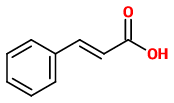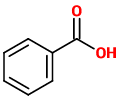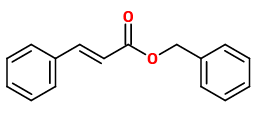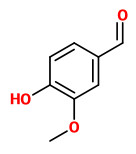Dies ist eine alte Version des Dokuments!
Styrax benzoin Dryand. - Styracaceae - Sumatra benzointree, Sumatra Benzoeharzbaum
Shrub or small tree, up to 12m high, native to Sumatra, Malaya and Java, introduced into West Africa.
http://plants.jstor.org/upwta/5_303
Benzoin resin is used as a fixative, slowing the dispersion of essential oils and other fragrance materials into the air, also in cosmetics, veterinary medicine, and scented candles. https://en.wikipedia.org/wiki/Benzoin_resin
„Since the 15th or 16th century compound tincture of benzoin has been used extensively to treat wounds, ulcers, fissures of the nipples, lips and anus, and similar conditions. For these purposes, the tincture was, and is, used as a balsam under different names (Balsam Traumatic, “baume de commandeur) and was incorporated in plasters (court plaster)… Within a relatively short period of time, three cases of acute dermatitis were observed from compound tincture of benzoin used in combination with adhesive tape dressings… An analysis of more detailed patch tests and their correlation with the constituents of compound tincture of benzoin and other balsams makes it appear probable that volatile oils and/or resins might be responsible for the dermatitis… Compound tincture of benzoin and its constituents should not be used on the skin of patients with an allergic disease or a history of allergy.“
[Investigation of Contact-type Dermatitis Due to Compound Tincture of Benzoin. Steiner, Karl, and William Leifer, Journal of Investigative Dermatology Vol.13.6, 1949, 351-359] http://www.nature.com/jid/journal/v13/n6/full/jid1949109a.html
„The odour of Benzoin is best described as sweet, balsamic and vanilla like… the characterising components are benzyl alcohol, the benzoresinyl benzoates and cinnamates together with some vanllin.“ Main components of the volatile fraction of Benzoin resin were benzyl alcohol (41.8%), benzoic aicd (2.5%), vanillin (1.4%), cinnamic acid (2.7%), benzyl benzoate (46.6%), and cinnamyl cinnamate (1.5%). Minor components were e.g. benzaldehyde, methyl benzoate, cinnamic alcohol, methyl cinnamate, ethyl cinnamate, nerolidol, cinnamyl benzoate and benzyl cinnamate.
[Moyler, D. A., R. A. Clery, and K. A. D. Swift. „Flavours and Fragrances.“ Special Publications No. 214 (1997): 96-115]
„According to data compiled by Burkhill (1966), Styrax tonkinensis and Styrax benzoin both contain benzo-resinol and traces of free fragrant substances, benzaldehyde, vanillin, phenylpropyl cinnamate, styrol, and styracin; but Styrax tonkinensis contains free benzoic acid, while Styrax benzoin contains free acid and holds lower quantities of vanillin and styrol; Styrax paralleloneurum yields a benzoin made up principally of cinnamic acid. A recent study was made on samples of different qualities of Styrax benzoin and Styrax paralleloneurum collected in North Sumatra (Pastorova & Boon, 1994). From the gas chromatograms, they identified six groups of components in all the samples: free benzoic acid, free cinnamic acid, free alcohols and vanillin, benzoic acid esters, cinnamic acid esters and higher molecular weight compounds. They concluded that quality of both the resins is correlated with the aromatic ester content. Styrax paralleloneurum contains primarily cinnamic acid esters and Styrax benzoin about equal amounts of cinnamic and benzoic acid esters. Lower grades contain mainly free benzoic and cinnamic acids and an amount of triterpenoids. It is very likely that the collectors and the traders mix the different species of Sumatra benzoin.“
[Experiences in benzoin resin production in Sumatra, Indonesia. Katz, E., Goloubinoff, M., Ruiz Perez, M., Michon, G., in: Mugah, J.O., Chikamai, B.N., Mbiru, S.S., Casadei, E.: Conservation, management and utilization of plant gums, resins and essential oils. (Nairobi 1997), 1998, 56-66] http://www.fao.org/3/a-x0098e.pdf#page=62
„The volatile extract composition of two different benzoin gums, Siam and Sumatra, were analysed by GC-MS. Twenty components representing more than 99.1% of the oil from Siam and 29 components representing more than 97.4% of the oil from Sumatra were analysed. The major components were… styrene (2.3%), cinnamic acid (3.5%) and benzyl cinnamate (3.3%) for Sumatra. Volatile compounds of oils and crushed benzoins were also studied using solid-phase microextraction (SPME) employing carboxen/polydimethylsiloxane and carbowax/divinylbenzene fibres.“
[Volatile constituents of benzoin gums: Siam and Sumatra. Part 1. Fernandez, X., Lizzani‐Cuvelier, L., Loiseau, A. M., Périchet, C., Delbecque, C., Flavour and fragrance journal, Vol.18(4), 2003, 328-333]
Sumatra resin may be produced from S.benzoin and/or S.paralleloneurum. Commercial samples contained styrene, isovanillin, a large quantity of free cinnamic acid, p-coumaryl cinnamate, and traces of free benzoic acid and p-coumaryl benzoate. S.paralleloneurum balsam showed more cinnamates than S.benzoin, and among these, p-coumaryl cinnamate is predominant.
[Analytical investigation of styrax and benzoin balsams by HPLC-PAD-fluorimetry and GC-MS., Hovaneissian, M., Archier, P., Mathe, C., Culioli, G., Vieillescazes, C., Phytochemical Analysis, 19(4), 2008, 301-310]
„… since perfumers consider it of higher quality than the Sumatra variety, Siam benzoin gum enters the formulas of fine fragrances such as Shalimar TM (Guerlain) or π TM (Givenchy) to give a sweet powdery vanilla note together with strong fixative properties. In contrast, Sumatra benzoin gum is extensively used in Asia not
only for healing wounds, erythema and cough but also for religious rites. Only the best qualities are used in fragrant compositions but Sumatra benzoin gum finds application in chocolate-type aromas to which it brings interesting warm and spicy notes.“
[An unusual acenaphthylene-type sesquiterpene hydrocarbon from Siam and Sumatra benzoin gum., Filippi, J.J., Castel, C., Fernandez, X., Rouillard, M., Gaysinski, M., Lavoine-Hanneguelle, S., Phytochemistry Letters, 2(4), 2009, 216-219]
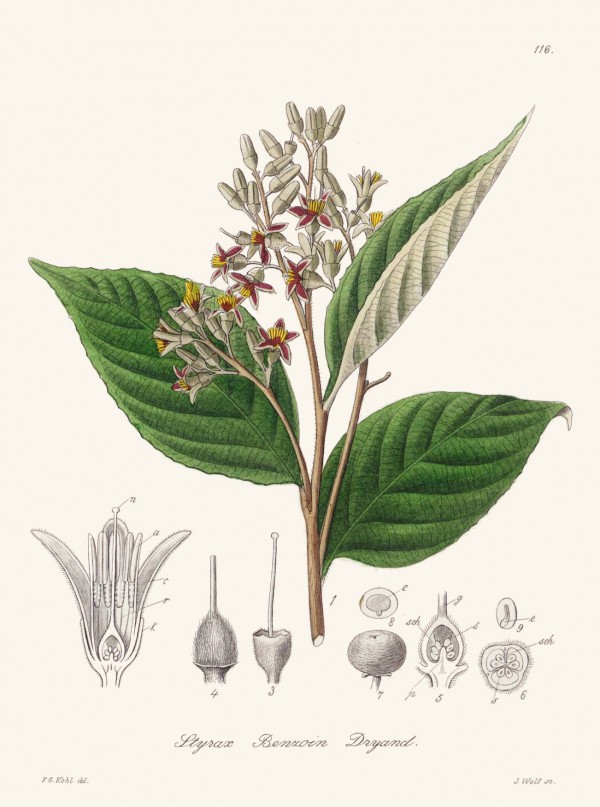
Kohl, F.G., Die officinellen Pflanzen der Pharmacopoea Germanica, t.116 (1891-1895)
http://plantgenera.org/species.php?id_species=986332

